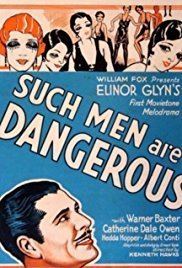6.4 /10 1 Votes6.4
Initial release 9 March 1930 | 6.4/10 IMDb Produced by Al Rockett Edited by Harold D. Schuster | |||||||||||||||||||||||||||||||||
 | ||||||||||||||||||||||||||||||||||
Starring Warner BaxterCatherine Dale OwenHedda HopperClaud AllisterAlbert ContiBela Lugosi Cinematography George EastmanL. William O'ConnellConrad Wells Music director Albert Hay Malotte, Peter Brunelli, Glen Knight Cast Similar Oh - For a Man!, Wild Company, The Veiled Woman, The Rejected Woman, The Silent Command | ||||||||||||||||||||||||||||||||||
Such men are dangerous
Such Men Are Dangerous is a 1930 American drama film directed by Kenneth Hawks and written by Ernest Vajda. The film is based on a novella by Elinor Glyn who based her story on the 1928 real-life disappearance of Belgian Banker Alfred Loewenstein whose aircraft vanished over the English Channel. The film stars Warner Baxter, Catherine Dale Owen, Hedda Hopper, Claud Allister, Albert Conti and Bela Lugosi. The film was released on March 9, 1930, by Fox Film Corporation.
Contents
Such men are dangerous 1930 excerpt
Plot
Elinor, encouraged by her ambitious sister, reluctantly agrees to marry wealthy businessman Ludwig Kranz. However she is repulsed by his un-attractive physical appearance and his aloof, materialistic personality. Unable to go through with consummating the marriage, Elinor flees on their wedding night.
Kranz angrily plots revenge, hiring a plane and heading out over the English Channel where he abandons the aircraft by parachute in order to fake his own death. Kranz goes to Berlin and bribes a plastic surgeon, Dr Goodman, to re-model his facial features. After months of work, Kranz is transformed into a different, and much more handsome, looking man. With a fake identity, Kranz returns to England and seeks out Elinor with the intention of seducing and then humiliating her. With his new face, Kranz adopts a warmer, more charming manner and inwardly his previously dour character begins to soften. Elinor falls in love with him and to his surprise, he discovers his feelings for her are heading the same way.
Kranz realizes that Elinor never married him for his wealth and that it was the cold, heartless manner of his prior self that drove her away the first time. Kranz decides he is prepared to forget the past and embarks on his new life and love with Elinor.
Cast
Production
During aerial-filming a short distance off the Californian coast near Santa Monica on 2 January 1930, two Detroiter aircraft employed as camera-planes collided whilst filming the parachute jump scene. According to witnesses on a nearby beach, the wingtips of the aircraft touched. The two planes swung together, colliding and bursting into flame. Both planes crashed into the ocean, killing all ten men on board including director Kenneth Hawks, cinematographer Conrad Wells, assistant director Max Gold, director of photography George Eastman, cameramen Otto Jordan and Ben Frankel, two property men and the two pilots, one of whom was an Army Reserve flier. Only five of the bodies were recovered. A coroner's inquiry into the incident did not attach blame to any specific incident or person.
Reception
The film received mixed reviews.
Mordaunt Hall, writing in the New York Times, praised the screenplay, saying that Ernest Vajda has done 'exceedingly well with a minimum number of words'. He also praised the cast, in particular Bela Lugosi for his 'sincere' performance as Dr Goodman.
